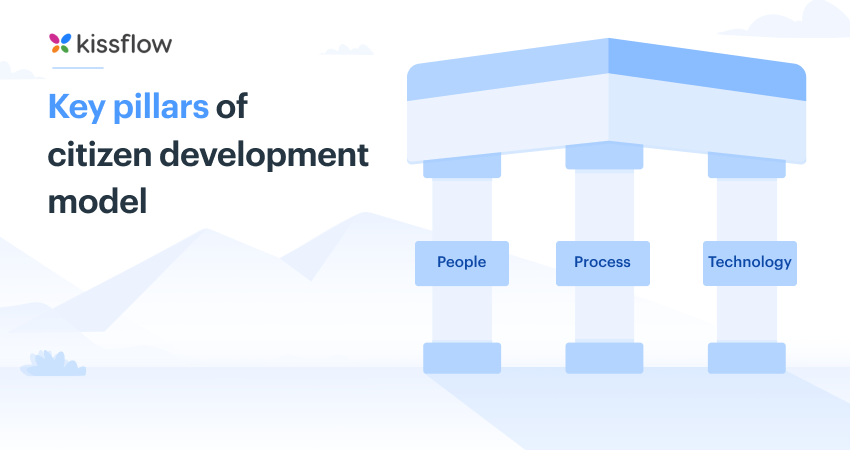
- >
- Citizen Development >
- Implementing a Citizen Development Model in Your Business Organization
Implementing a Citizen Development Model in Your Business Organization
Team Kissflow
Updated on 23 Apr 2025 • 6 min read
Enter the concept of citizen development. While not entirely new, its potential impact on business growth is only now being fully recognized by enterprises worldwide. More than just democratizing software development, citizen development tackles the bottlenecks in digital transformation head-on.
As a CIO or a business transformation professional, understanding and harnessing citizen development can be a game-changer. It's about empowering non-IT staff to create solutions, reducing the burden on IT departments, and fostering a culture of innovation across the organization.
However, tapping into this potential requires more than just understanding the concept. It involves carefully implementing the model within your organization. This means providing the right tools, creating a supportive environment, and ensuring clear governance to maintain security and compliance.
What is a citizen development model?
Citizen development model is a business framework that allows non-programmer employees (called citizen developers) to build business-critical applications. A citizen developer leverages no code or low-code platforms to design and create applications. The term citizen developer is a persona and not a role.
With the citizen developer framework, employees become citizen developers who are able to create model-based solutions with the capabilities necessary for their business processes. They are able to do so even without formal software development training or a background in information technology. With this, software developers can focus on more complex development projects critical to the complete digital transformation of an organization.

The No-Code Approach to Unlock Citizen Development Excellence
Thank you for downloading!
Key pillars of the citizen development model
The success of the citizen developer model requires a strong foundation where key elements are solidly in place. The three pillars critical to the implementation of this framework are
- people,
- process, and
- technology
People
Citizen development relies on having the right people on board. Citizen developers work alongside practice managers, coaches, and professional developers—each one playing an essential role in the success of the citizen development program.
For smooth collaboration, there must be clearly defined roles and responsibilities for all persons involved. It’s important to foster a community of practice that promotes continuous learning, enablement, and sustainable growth.
Process
The right process ensures standardized delivery of automation solutions. It ensures that citizen developers and their outputs adhere to testing, maintenance, and reporting guidelines. These guidelines must be defined clearly, and the scope of automation must be delineated.
Technology
Deploying the right technology is crucial to the success of citizen development. It must complement and augment the people and process pillars of a development program. It must create a development environment that fosters collaboration, enforces compliance, and delivers business value.
To create applications for intelligent workflow, businesses must utilize technology that works with internal processes and governance structures. The technology must be easy for enterprise IT to manage and easy for citizen developers to use and reuse.
Learn more: How Does Citizen Development Accelerate Business Sustainability?
What are the benefits of citizen development?
The all-encompassing benefit of implementing a citizen development model is accelerating and overcoming the challenges of digital transformation within organizations. Some of the more specific benefits include better business agility, an augmented development team, and faster deployment of enterprise apps.
Enhances business agility
The business landscape is evolving at lightning speed. There are constantly new consumer and employee demands. Without an equally fast delivery of new solutions, businesses will be unable to keep up with these needs. As citizen developers help create appropriate solutions, businesses become more agile and adapt to changes more quickly.
Augments the developer shortage
According to a recent Reveal survey[1], recruiting skilled developers is one of the top challenges businesses face this year. This talent shortage slows down digital transformation in many enterprises. Citizen development helps address this problem by offsetting the IT workload for citizen developers. This then enables software developers to focus on creating more technically complex applications that allow businesses to deliver solutions faster.
Accelerates deployment of enterprise app
Citizen developers are more familiar with the processes they use. This puts them in a better position to assess what solutions they need. By giving them the right citizen development tools, they can create applications and functionalities that can be easily integrated into existing processes and quickly deployed across all channels they use.
Challenges in implementing citizen development
While the citizen development framework benefits business efficiency and growth, it poses risks and challenges. Two of the most critical ones are
- The risk to security
- The lack of internal governance
Risk to security
Enabling citizen development gives a large number of people access to data as they create applications. To avert this risk, you must ensure that you have appropriate security measures in place and that enterprise data is well-protected.
Lack of internal governance
If there are no appropriate boundaries in place, citizen developers might create applications that don’t work well with your existing infrastructure. There’s also the risk of creating irrelevant applications or making unnecessary iterations in current applications. Without governance control, the program will likely fail and result in losses in productivity and revenue.
Learn more: Why Do You Need Governance In Citizen Development?
“Citizen developers employing low-code and no-code have the potential to be the talent shortage's saving grace. Alongside the booming of low-code and no-code platforms and citizen developers, IT departments have been freed up from a resource perspective, allowing them to evolve beyond cost centers and into more proactive implementers of technology, overseeing policy, compliance, and identifying new business opportunities and streams of revenue." - Stanley Huang, co-founder and CTO at Moxo.
How to implement a citizen development model?
Every company has its unique business structure and needs, so the implementation of citizen development models varies. Still, there are recommendations on how to successfully implement the framework and optimize its benefits.
Train citizen developers
While the citizen developer model works on the premise that no IT knowledge is required, users must still be trained on how to optimize the use of development tools. As you start your implementation, conduct comprehensive training on building applications, management practices, information security, agile environments, and other aspects of development relevant to your business processes.
Learn more: Gartner on Citizen Development
Control user access
Avert security risks by granting role-based access to data and development tools. Unbridled access to everything can pose threats to your entire structure, as citizen developers may unwittingly explore areas they’re not familiar with and inadvertently make changes that lead to software malfunctions.
Foster collaboration between IT teams and business users
Citizen development initiatives can only be successful if there’s a collaboration between IT and business. They must communicate openly and align their goals. IT teams must put standards in place for citizen developers to create citizen development apps that comply with governance policies.
Find the right tools
Developing applications can be tricky, especially for those who have limited knowledge of programming. Without the right tools, citizen developers will end up having to ask IT teams for help and guidance. This defeats the goal of offloading IT teams of simple tasks. So the right tools must be in place to enable effective citizen development.
Why is it essential to deploy the right citizen developer tools?
The success of your citizen development model relies heavily on the citizen developer tools you use for its implementation. The tools must empower your citizen developers without burdening your IT teams. They must provide makers with greater autonomy while ensuring compliance with set standards.
They must be easy to use, so citizen developers can build and deploy solutions faster. To accelerate application delivery, you must find the right citizen development platform with the tools that meet the specific needs of your business.
How McDermott improved their process efficiency using Kissflow
McDermott, a leading engineering and construction solutions provider, faced significant challenges with an overburdened IT team supporting 6,000 business users and a complex application landscape. Furthermore, a lack of an ERP system led to numerous discrete applications, complicating workflows.
Renee Villarreal, the Senior Director of IT, sought a solution that would allow business users to build their own applications and streamline operations independently. The tool needed to be user-friendly, secure, and integrate well with existing systems like SharePoint.
Kissflow emerged as the perfect fit, offering intuitive, straightforward functionality that empowered users to handle their workflows without IT support. This ease of use led to widespread adoption across the organization, even without a formal campaign. Kissflow's mobile application was another advantage, providing quick accessibility for users.
The platform proved particularly beneficial for the HR team, who could quickly build applications and streamline various workflows. It also enabled business users to identify and resolve bottlenecks in their processes.
Within a year, McDermott processed over 23,000 work items, had 5,526 active users and created 132 active workflows without relying on IT. The company now plans to standardize all workflows across its offices using Kissflow.
Kissflow is the way to go
IT departments in many organizations find themselves perpetually navigating a sea of growing backlogs and ceaseless solution requests. This is where the empowering principle of citizen developers shines as a lifeline. By leveraging this approach, companies can effectively combat budget and staffing challenges using the right no-code platform as their springboard.
Kissflow's low-code platform is a prime example of this tool. Engineered for simplicity and ease of use, it serves as a catalyst, swiftly morphing business users into capable citizen developers. Its visually appealing drag-and-drop form builder, complemented by an array of pre-built templates, empowers users to streamline workflows and craft bespoke business applications with minimal coding.
While Kissflow champions business users to independently create applications, it simultaneously ensures that IT maintains a firm grip on data governance. This dual approach ensures unwavering security and compliance, offering a sense of tranquility amidst the pursuit of innovation.
Discover the Power of Citizen Development with Kissflow
Related Articles












